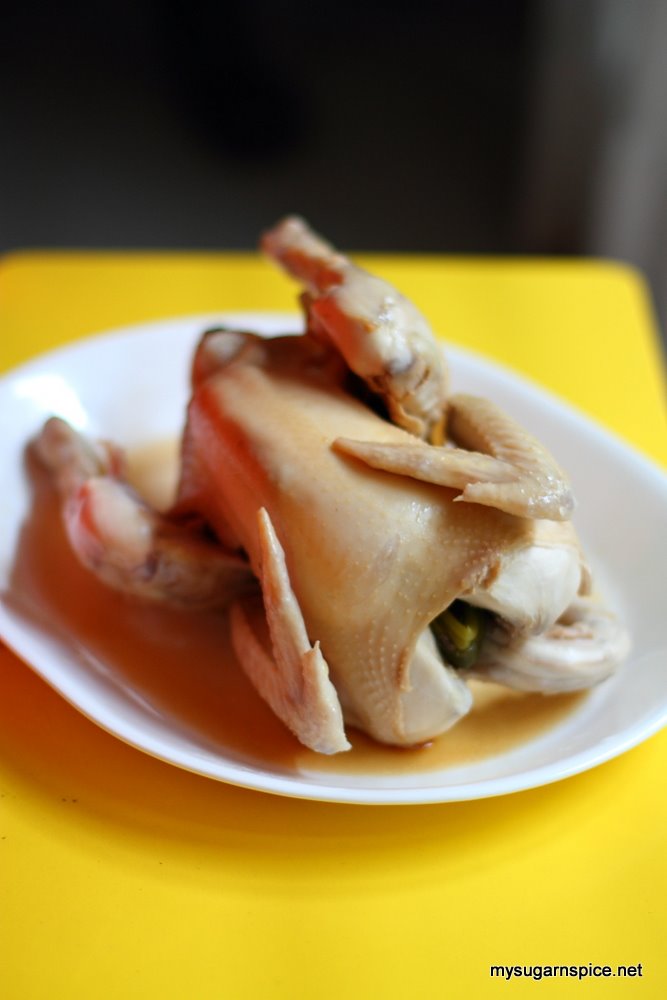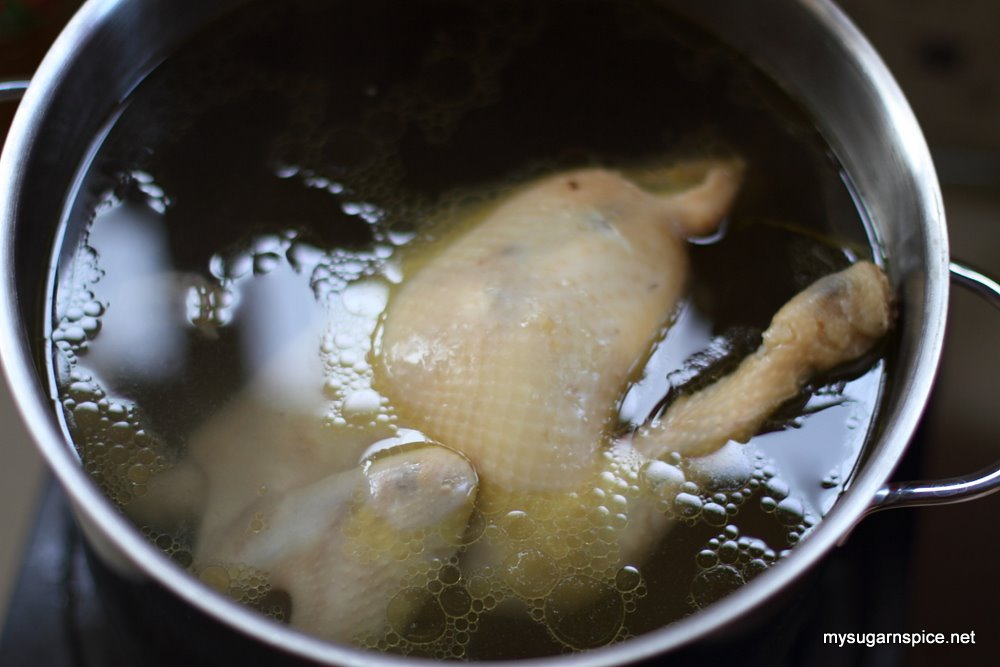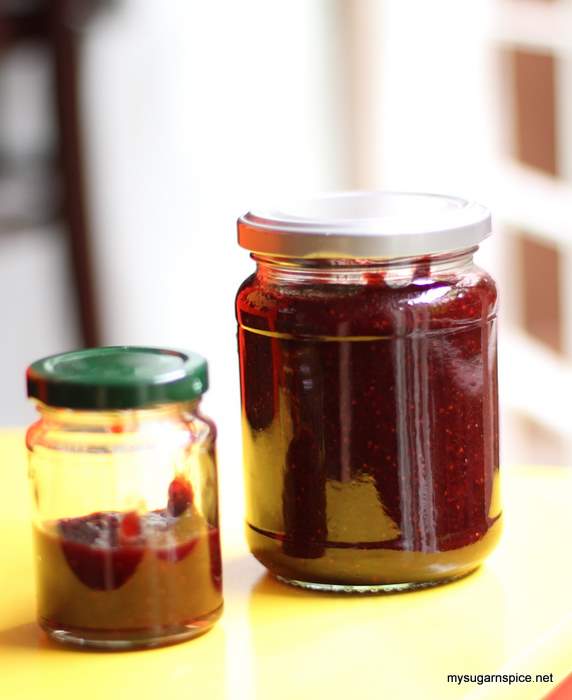I used to make lots of business trips to Singapore, and will meet up with colleagues from other part of the world; most of them when asked what they wanted to eat in Singapore, would ultimately say, "Chicken Rice." (but of course not before they have a crab meal).
Although in Malaysia we have Hainanese Chicken rice too and we do have some really good Chicken rice stalls or shops here, but in general, I find Hainanese Chicken rice in Singapore nicer, maybe because everything there is of better quality, or they have a special way of cooking it.
 And, I happen to find it. Here is a recipe I'd used and reused many times from Chubby Hubby, a Singaporean, whose blog site I used to (actually, still do) go to gawk at the beautiful photos taken, and the pretty dishes presented way back when I just started blogging.
And, I happen to find it. Here is a recipe I'd used and reused many times from Chubby Hubby, a Singaporean, whose blog site I used to (actually, still do) go to gawk at the beautiful photos taken, and the pretty dishes presented way back when I just started blogging.
I make this occasionally for dinner at home and try to use the best ingredients. My youngest daughter love chicken, and this is definitely healthier than having fried chicken all the time; my eldest although does not like steam chicken, likes the rice and the accompanied soup.
Just a note, if you are like me, who only goes to the market once a week, and would sure have frozen your chicken even though you bought it fresh; make sure you take it out of the frezer to thaw in the morning. The time taken to get the chicken seasoned, cooked is about 2.5hrs, so you need to start cooking early or you might end up having late dinner.
♥Hainanese chicken rice♥
Adapted from Hainanese Chicken Rice by Chubby Hubby
Serves 5
You'll need :
1 fresh whole free range or kampung chicken (about 1kg)
1 tsp salt
1 tbs light soya sauce
1 tsp Chinese rice wine
2 pieces of ginger, each about 1 inch thick, lightly bruised with the back of a knife
1 garlic clove, peeled and lightly bruised
1 stalk of spring onion
1 tsp sesame oil
For the rice
2 cups long grain jasmine rice (I use Bismati, as we don't take jasmine rice at home)
2 1/2 cups chicken stock (obtained from cooking the chicken; see recipe)
chicken fat (I use 3 tbs of vegetable oil instead)
1 tbs finely minced ginger
5 garlic cloves, peeled and finely minced
1 tsp sesame oil
1 tsp salt
1 pandan leaf, tied into a knot
Chilli sauce for dipping
10 fresh red chillies, seeds removed from half, chopped
10 garlic cloves, peeled and chopped
1 tbs vegetable oil
1 tbs chicken stock (obtained from cooking the chicken; see recipe)
salt, to taste
sugar, to taste
calamansi juice, to taste
Method to cook the chiken :
1) Remove the fat from the cavity of the chicken and set aside for use in flavouring the rice later (if you are using). Vigorously rub the cavity and exterior with salt. Then rub the chicken cavity with 1/2 tablespoon of the soy sauce and all of the rice wine. Stuff the cavity with ginger, garlic and spring onion. Set aside for 1 hour (not in the fridge).
2) Bring a deep stockpot, filled with enough water to cover the chicken, to the boil. Lower the chicken into the pot—it should be completely immersed. Immediately turn off the heat, cover, and leave to stand for a total of 1 hour. At every 15-minute intervals, lift the chicken and drain the water from the cavity to ensure that the chicken cooks inside as well. At the 30-minute mark, reheat the water almost to boiling point, then turn the heat off.
 By never having been allowed to boil, the chicken should be cooked to succulent and juicy perfection.
By never having been allowed to boil, the chicken should be cooked to succulent and juicy perfection.
3) At the end of the hour, remove the chicken from the pot, and plunge into a large bowl of iced water to arrest further cooking. Once cool (about 15 to 20 minutes), drain the chicken thoroughly.
If you are like my sister's helper and mine, who's confused about how to do step 2, and move to step 3, here is what I tell them. Assuming the water in the pot gets boiled at 5pm :
5:00pm - Immerse the chicken into the boiled water, and turned off the heat
5:15pm - lift the chicken out and drain the water from the cavity, then immerse the chicken into the hot water again.
5:30pm - lift the chicken out and drain the water from the cavity. Reheat the water almost to boiling point. Immerse the chicken into the boiled water and turned off the heat.
5:45pm - lift the chicken out and drain the water from the cavity, then immerse the chicken into the water again.
6:00pm - remove the chicken out from the pot and drain the water, time to give the chicken a ice bath.
4) Rub it down with the remaining 1/2 tablespoon of soy sauce and sesame oil. Snip off the chicken wing tips, neck, and legs (we didn't because this are the bits that my helper likes). Toss these into the liquid left in the stockpot. Set the chicken aside, covered, until ready to serve.
5) To serve, just cut them into pieces.
 Method to cook ther rice
Method to cook ther rice
(Note : it's different from how Chubby Hubby does his, because we do not have time to boil and wait until the stock is reduced to the required amount.)
1) Wash the rice like you normally would. Drain thoroughly.
2) Strain the stock. Measure out enough stock you'll need for cooking the rice.
3) Normally, we'll start boiling the rest of the stock to soup. You can make any types of chicken soup. Sometimes we'll make it into something light by adding raddish and carrot; sometimes we'll make it into lotus root soup by adding lotus root and kudzu root (fun-kot, 粉葛); or we'll make bean soup by adding in light speckled kidney beans (jan-chu dao, 珍珠豆) to boil.
4) If you are using chicken fat, place the chicken fat set aside earlier the wok. Cook on a low heat to render the fat (there should be about 3 tablespoons worth). For us, we heat up the vegetable oil.
5) Add the ginger and garlic, and fry gently until aromatic without browning. Add the drained rice and sesame oil, stirring well to coat each grain with fat.
6) Transfer the rice into your rice cooker, substitute chicken stock for the amount of water you would ordinarily add to cook the same amount of rice. Add the pandan leaf and salt. And let the rice cooker do the work.
Method to make the chilli sauce
Process or blend the chillies, garlic and ginger to a fine paste, adding the oil and chicken stock (from what was reserved earlier) to facilitate the process. Scrape into a bowl. Stir in salt, sugar and lime juice to taste.
We make the ginger sauce separately, and mix it with chilli sauce in a saucer to serve. Recipe for ginger sauce can be found here.
I realised, it's sooooo difficult to take photo of a whole chicken and a plate of chopped up chicken. They somehow turned out not looking 'appetising', but trust me, the chicken is very tender and juicy. Normal breast meat from the chicken rice shop may be tough, but the way this chicken is cooked, produced juicy and soft pieces.
Although in Malaysia we have Hainanese Chicken rice too and we do have some really good Chicken rice stalls or shops here, but in general, I find Hainanese Chicken rice in Singapore nicer, maybe because everything there is of better quality, or they have a special way of cooking it.
 And, I happen to find it. Here is a recipe I'd used and reused many times from Chubby Hubby, a Singaporean, whose blog site I used to (actually, still do) go to gawk at the beautiful photos taken, and the pretty dishes presented way back when I just started blogging.
And, I happen to find it. Here is a recipe I'd used and reused many times from Chubby Hubby, a Singaporean, whose blog site I used to (actually, still do) go to gawk at the beautiful photos taken, and the pretty dishes presented way back when I just started blogging. I make this occasionally for dinner at home and try to use the best ingredients. My youngest daughter love chicken, and this is definitely healthier than having fried chicken all the time; my eldest although does not like steam chicken, likes the rice and the accompanied soup.
Just a note, if you are like me, who only goes to the market once a week, and would sure have frozen your chicken even though you bought it fresh; make sure you take it out of the frezer to thaw in the morning. The time taken to get the chicken seasoned, cooked is about 2.5hrs, so you need to start cooking early or you might end up having late dinner.
♥Hainanese chicken rice♥
Adapted from Hainanese Chicken Rice by Chubby Hubby
Serves 5
You'll need :
1 fresh whole free range or kampung chicken (about 1kg)
1 tsp salt
1 tbs light soya sauce
1 tsp Chinese rice wine
2 pieces of ginger, each about 1 inch thick, lightly bruised with the back of a knife
1 garlic clove, peeled and lightly bruised
1 stalk of spring onion
1 tsp sesame oil
For the rice
2 cups long grain jasmine rice (I use Bismati, as we don't take jasmine rice at home)
2 1/2 cups chicken stock (obtained from cooking the chicken; see recipe)
chicken fat (I use 3 tbs of vegetable oil instead)
1 tbs finely minced ginger
5 garlic cloves, peeled and finely minced
1 tsp sesame oil
1 tsp salt
1 pandan leaf, tied into a knot
Chilli sauce for dipping
10 fresh red chillies, seeds removed from half, chopped
10 garlic cloves, peeled and chopped
1 tbs vegetable oil
1 tbs chicken stock (obtained from cooking the chicken; see recipe)
salt, to taste
sugar, to taste
calamansi juice, to taste
Method to cook the chiken :
1) Remove the fat from the cavity of the chicken and set aside for use in flavouring the rice later (if you are using). Vigorously rub the cavity and exterior with salt. Then rub the chicken cavity with 1/2 tablespoon of the soy sauce and all of the rice wine. Stuff the cavity with ginger, garlic and spring onion. Set aside for 1 hour (not in the fridge).
2) Bring a deep stockpot, filled with enough water to cover the chicken, to the boil. Lower the chicken into the pot—it should be completely immersed. Immediately turn off the heat, cover, and leave to stand for a total of 1 hour. At every 15-minute intervals, lift the chicken and drain the water from the cavity to ensure that the chicken cooks inside as well. At the 30-minute mark, reheat the water almost to boiling point, then turn the heat off.
 By never having been allowed to boil, the chicken should be cooked to succulent and juicy perfection.
By never having been allowed to boil, the chicken should be cooked to succulent and juicy perfection.3) At the end of the hour, remove the chicken from the pot, and plunge into a large bowl of iced water to arrest further cooking. Once cool (about 15 to 20 minutes), drain the chicken thoroughly.
If you are like my sister's helper and mine, who's confused about how to do step 2, and move to step 3, here is what I tell them. Assuming the water in the pot gets boiled at 5pm :
5:00pm - Immerse the chicken into the boiled water, and turned off the heat
5:15pm - lift the chicken out and drain the water from the cavity, then immerse the chicken into the hot water again.
5:30pm - lift the chicken out and drain the water from the cavity. Reheat the water almost to boiling point. Immerse the chicken into the boiled water and turned off the heat.
5:45pm - lift the chicken out and drain the water from the cavity, then immerse the chicken into the water again.
6:00pm - remove the chicken out from the pot and drain the water, time to give the chicken a ice bath.
4) Rub it down with the remaining 1/2 tablespoon of soy sauce and sesame oil. Snip off the chicken wing tips, neck, and legs (we didn't because this are the bits that my helper likes). Toss these into the liquid left in the stockpot. Set the chicken aside, covered, until ready to serve.
5) To serve, just cut them into pieces.
 Method to cook ther rice
Method to cook ther rice (Note : it's different from how Chubby Hubby does his, because we do not have time to boil and wait until the stock is reduced to the required amount.)
1) Wash the rice like you normally would. Drain thoroughly.
2) Strain the stock. Measure out enough stock you'll need for cooking the rice.
3) Normally, we'll start boiling the rest of the stock to soup. You can make any types of chicken soup. Sometimes we'll make it into something light by adding raddish and carrot; sometimes we'll make it into lotus root soup by adding lotus root and kudzu root (fun-kot, 粉葛); or we'll make bean soup by adding in light speckled kidney beans (jan-chu dao, 珍珠豆) to boil.
4) If you are using chicken fat, place the chicken fat set aside earlier the wok. Cook on a low heat to render the fat (there should be about 3 tablespoons worth). For us, we heat up the vegetable oil.
5) Add the ginger and garlic, and fry gently until aromatic without browning. Add the drained rice and sesame oil, stirring well to coat each grain with fat.
6) Transfer the rice into your rice cooker, substitute chicken stock for the amount of water you would ordinarily add to cook the same amount of rice. Add the pandan leaf and salt. And let the rice cooker do the work.
Method to make the chilli sauce
Process or blend the chillies, garlic and ginger to a fine paste, adding the oil and chicken stock (from what was reserved earlier) to facilitate the process. Scrape into a bowl. Stir in salt, sugar and lime juice to taste.
We make the ginger sauce separately, and mix it with chilli sauce in a saucer to serve. Recipe for ginger sauce can be found here.
I realised, it's sooooo difficult to take photo of a whole chicken and a plate of chopped up chicken. They somehow turned out not looking 'appetising', but trust me, the chicken is very tender and juicy. Normal breast meat from the chicken rice shop may be tough, but the way this chicken is cooked, produced juicy and soft pieces.
 2) Place the strawberries into a large bowl with the sugar. Turn carefully to mix and coat well, then cover with cling film and place into the fridge for about 3hrs (the reciepe asked that it be refrigerated over night), let them macerate.
2) Place the strawberries into a large bowl with the sugar. Turn carefully to mix and coat well, then cover with cling film and place into the fridge for about 3hrs (the reciepe asked that it be refrigerated over night), let them macerate.
 The cooking of the jam made the whole house smell sweet and lovely.
The cooking of the jam made the whole house smell sweet and lovely.